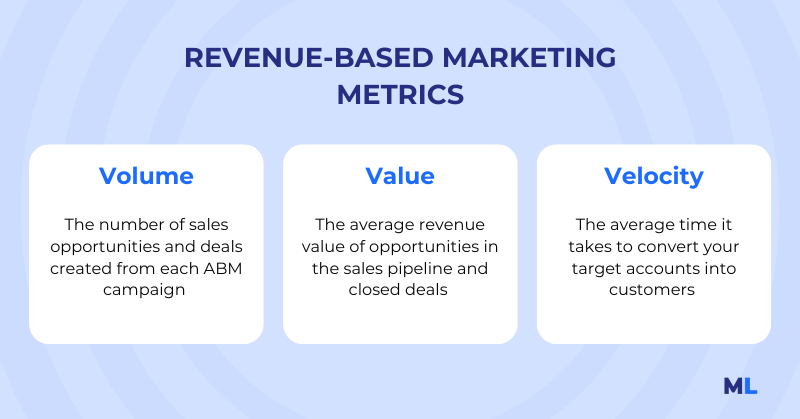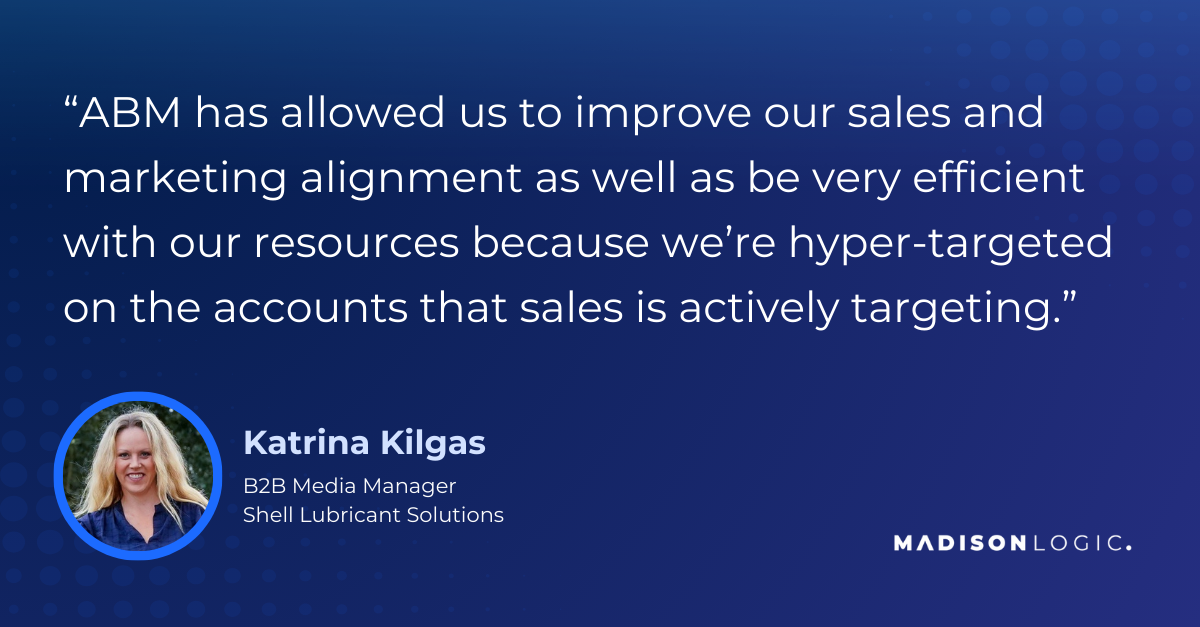
Unlock Global ABM at Scale — Madison Logic strengthens ABM reach with Connected TV and Audio expansion globally. Learn More
Unlock Global ABM at Scale — Madison Logic strengthens ABM reach with Connected TV and Audio expansion globally. Learn More

Change is constant—in buyer behavior, in technology, and in marketing itself. The B2B industry is always susceptible to economic shifts, evolving trends, and external market forces, making it critical that marketing efforts are tied directly to business outcomes.
Traditionally, marketing efforts have focused on top-of-funnel activities such as generating leads and bringing accounts into the pipeline for sales to convert. But as the pressure to prove impact grows in an environment of constant change, marketers who align with bottom-line results will drive more effective, revenue-centric strategies that attract and engage high-value accounts.
This shift emphasizes another type of marketing—revenue-based marketing (RBM)—where success is measured not by leads alone, but by actual contribution to revenue. RBM emphasizes account-based marketing (ABM), personalization at scale, closer alignment with sales, and a laser focus on business outcomes.
Revenue-based marketing is a strategic approach that focuses on driving measurable revenue through marketing efforts. It combines personalized campaigns, marketing analytics, and marketing automation to attract, nurture, and convert leads into customers. A core component of this approach is attribution, which accurately tracks which marketing activities influence revenue outcomes. By aligning closely with sales and leveraging attribution models, RBM ensures every action is accountable and directly tied to business impact.
The following are the key components that make RBM effective and sustainable:
In revenue-based marketing, personalization goes far beyond simply addressing someone by “Hi, {first_name}” in an email. It’s about delivering the right message, at the right time, through the right channel, based on real insights into an account’s needs, behaviors, and buying stage. Let’s take a look at how personalization can be leveraged deeper in RBM:
To move beyond surface-level tactics, marketers must use quality data to deliver highly relevant, tailored experiences to each target account. Advanced personalization techniques leverage intent data to uncover what accounts are interested in, where they are in the buying journey, and who the key decision-makers are. This data includes:
Data-driven insights allow for deeper personalization at an account level. Marketers can tailor ABM content based on industry, company size, pain points, buying stage, and individual roles within the account. This includes dynamic website experiences that adapt in real time, personalized email sequences that reflect account-specific challenges, and landing pages curated for each account or vertical.
Effective personalization also means creating content that speaks to both the strategic priorities of the organization and the personal motivations of individual buyers. These efforts deepen ABM engagement, accelerate deal cycles, and elevate marketing as a critical partner in revenue generation.
Artificial intelligence and advanced analytics power personalization at scale. AI solutions can predict buying intent, recommend next-best actions, and dynamically customize content based on user behavior and engagement history. Data analytics uncover patterns and preferences that inform more precise targeting and messaging. Together, AI and data analytics ensure that personalization is both data-driven and impactful, boosting conversion rates and strengthening customer relationships.
Leveraging AI tools is a powerful way to enhance your RBM efforts. For example, ML SmartReach helps supercharge your account personalization and outreach by transforming real-time buyer insights into AI-driven communication scripts for quality lead handoff. This is just one example of how AI can help streamline and deliver highly personalized interactions.
When sales and marketing work separately, valuable opportunities often slip through the cracks. By aligning around shared goals, integrated processes, and unified data, teams can build a stronger pipeline and drive faster growth. In an RBM strategy, this kind of collaboration isn’t optional, it’s critical. Achieving this alignment starts with these two steps:
In many organizations, sales and marketing teams operate in silos, leading to misaligned strategies and missed opportunities. To foster collaboration and achieve shared revenue goals, it’s essential to implement strategies that bridge these gaps:
To align marketing and sales, it’s essential to define unified key performance indicators (KPIs) that reflect the shared responsibility of both teams in driving pipeline and revenue. These KPIs should go beyond traditional lead counts to measure true impact across the entire buying journey. Examples include:
Additionally, campaign performance metrics reveal how accounts move through the sales funnel while also unveiling areas of the campaign and overall buyer’s journey to optimize. Pay attention to these ABM KPIs:

By leveraging ABM through Madison Logic, Shell Lubricant Solutions strengthened marketing and sales alignment, enabling hyper-targeted engagement with high-priority accounts. This focused approach not only improved resource efficiency but also accelerated pipeline progression—tying strategic targeting directly to revenue impact.

Building an effective RBM strategy requires more than alignment: it’s about having a clear execution strategy. The following action items are key to activating an account-based approach that ties marketing efforts directly to revenue impact.
The foundation of any RBM or ABM strategy starts with identifying the right accounts. Not every account is created equal. High-value accounts represent the most strategic fit and highest revenue potential. Segmenting your target account list allows marketing and sales to focus on signals and behaviors from the accounts that matter most, ensuring resources are invested where they’ll deliver the greatest return.
Using the right data and information, you can segment and prioritize the accounts most likely to convert. Leverage what’s already at your fingertips, including:
Once you’ve identified the right accounts, the next step is crafting campaigns that resonate. Personalization is key, not just at the account level, but at the B2B buyer level. Understanding the unique pain points, priorities, and motivations of each buying group member allows you to deliver relevant content that keeps your brand top of mind throughout the funnel. The goal is to build trust and guide accounts toward conversion through tailored engagement.

A well-executed RBM strategy meets buyers where they are. With large buying committees (Gartner estimates 14 to 23 members per deal), relying on a single channel simply isn’t enough. A multi-channel ABM approach ensures your message is seen across multiple touchpoints. Ideal marketing channel mix strategies to reach B2B buyers include:
More channels mean more opportunities to engage the full buying committee, influence decision-making, and accelerate deals through the funnel. When each channel is selected and activated with purpose, marketing efforts become more measurable and directly tied to revenue outcomes.
Perhaps the most important piece of revenue-based marketing is attribution, tying every action back to revenue. RBM isn’t just about doing more, it’s about knowing what works. Let’s break down the metrics, models, and best practices that help teams track performance, prove marketing’s contribution to growth, and continuously optimize their campaigns and marketing efforts.
High-level KPIs are essential for strategic planning and decision-making. KPIs are typically reviewed over longer periods, such as quarterly or annually, to gauge progress toward larger business goals. Track the following metrics to accurately track the effectiveness of your RBM efforts:
Understanding marketing’s role in driving pipeline and revenue means closely tracking spend and performance. These KPIs help teams optimize how quickly they earn back CAC and guide investment in high return campaigns.
Choosing the right model depends on your sales cycle, tech stack, and level of data maturity, but even simple attribution can unlock powerful insights.
Just as buyer behavior, market dynamics, and technology evolve, so should your approach to revenue-based marketing. Campaign optimization isn’t a one-time task—it’s a continuous process of learning, testing, and improving.
To keep your RBM strategy effective in a constantly evolving landscape, you should leverage data to:
With regular analysis and adjustment, teams can unlock greater efficiency, boost engagement, and maximize revenue impact from every marketing motion.
While RBM offers clear benefits, it also requires careful planning, strong alignment, and operational maturity to execute effectively. Let’s dive into common ABM challenges marketers might face when adopting RBM and strategies for overcoming them.
To overcome these challenges, organizations need a centralized data strategy, a reliable and integrated tech stack, and cross-functional collaboration to ensure every team is working from the same, up-to-date source of truth. Clean, transparent, and connected data is essential for delivering relevant, revenue-driving experiences.
Change is hard and it rarely happens overnight. Sales teams , in particular, may be hesitant to shift established habits or workflows. Success depends on securing cross-functional buy-in and helping every team member understand not just what they’re doing differently, but why it matters in the broader context of driving revenue. Here are a few strategies to proactively manage change:
RBM isn’t a one size fits all strategy—it should adjust and grow with your organization. As teams evolve, priorities shift, and market dynamics change, your approach to RBM must remain agile and forward-looking. Here’s how we recommend ensuring scalability when adopting RBM:
As B2B marketing and ABM continue to evolve, so does the role of revenue-based marketing. The best account-based marketing campaigns and RBM strategies will need to adapt to emerging marketing trends, technological advancements, and shifting market dynamics, ensuring they remain aligned with business goals and drive measurable revenue growth.
Advancements in technology and shifting market dynamics are reshaping RBM strategies. To stay competitive and drive revenue, marketers need to stay ahead of the curve. Below are a few key developments shaping the future of RBM that smart teams are already leaning into:
In revenue-based marketing, the customer journey doesn’t end at conversion—it’s actually just beginning. Integrating customer feedback and experience data into your strategy helps uncover insights that fuel upsell opportunities, reduce churn risk, and strengthen loyalty. When marketing, sales, and customer success all listen and respond to the voice of the customer, it drives not just satisfaction, but sustained revenue growth.

Revenue-based marketing will only grow more critical as B2B organizations become increasingly focused on tying buying committee actions and ABM motions back to the bottom line. RBM gives marketing a strategic voice by clearly showing how campaigns influence revenue.
Looking ahead at our B2B marketing predictions, we’ll see tighter alignment not just between marketing and sales, but across the entire go-to-market team, including customer success. With stronger attribution models and better cross-functional visibility, organizations will shift from reactive planning to proactive, data-driven decision-making.
A fully optimized RBM strategy doesn’t happen overnight. Start by defining what success looks like for your organization, then implement clear steps toward that goal. As your strategy starts to mature, invest in the technology, talent, and processes that transform your marketing from simply generating leads to actively attributing revenue.
Aligning your ABM strategy with sales goals ensures every campaign drives impact, every team works in sync, and every action is tied back to revenue. That’s where Madison Logic comes in. Our platform helps unify data, align marketing and sales, and activate campaigns in real time, so you can identify in-market accounts, engage decision-makers, and continuously optimize for better outcomes. If you are ready to start building a foundation for scalable revenue growth, download the 2025 ABM Playbook for actionable strategies to put these strategies into action.